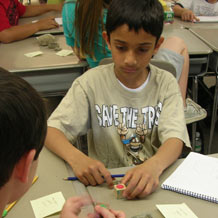What does it mean to take up space?
2. Order objects by space
This is the heart of the investigation, where students put objects in order according to volume, here expressed as “the amount of space they take up.” Four objects are provided — three cubes and the plastic modeling clay — others students must imagine (three fruits).
Note: The cubes are a test to see whether students can separate volume from weight. Since the cubes are the same size, they should be set side by side, but some students may still be seduced by weight. Do some think the heavier copper cube takes up more space than the pine cube? If so, recall their earlier observations about “heavy for size” and “light for size.”

These students are uncertain where to put the two cubes. They are the same size, but have different weights. Where should they go?
Give each group the three cubes and the plastic modeling clay to put in a line according to the amount of space they take up. The task will be straightforward unless the students become sidetracked by weight. Do they heft the objects to compare their weights? Do they talk about “heavier” and “lighter”? If so, remind them they are not comparing weight anymore. Tell them that they should be using their eyes and not their sense of felt weight to order things by how “much space they take up.”
As students finish, have them draw the four objects, in order, in their notebooks, labeling each object. If there is more than one opinion about the order, each student can record the order that seems correct.
As a group finishes ask each student to think of three pieces of fruit: one that takes up a lot of space, one that takes up very little space, and one in between. Have students draw and label the three pieces of fruit in their notebooks. This thought experiment is a higher–order exercise, requiring students to consider volume without handling the objects. If they need help, perhaps suggest that they model the fruit in the air with their hands.



